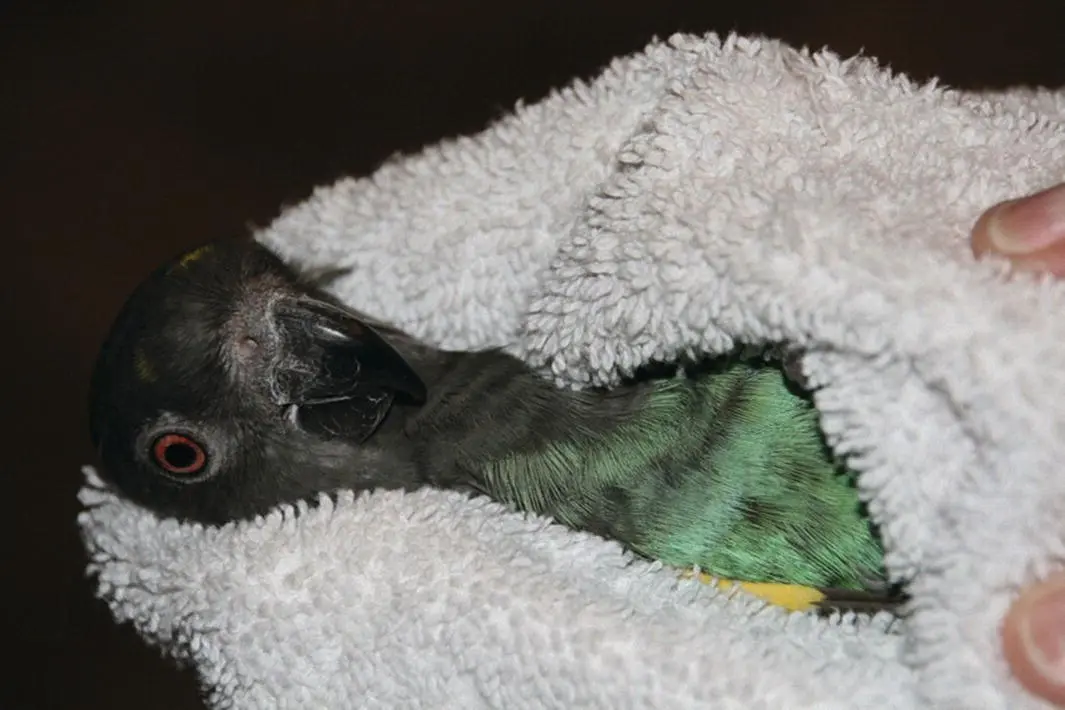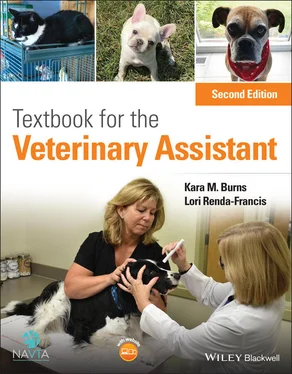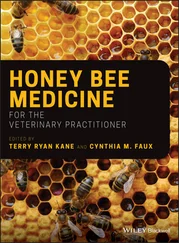Restraint is a very stressful experience for a bird. Allow the examiner to move as quickly as possible to insure the bird is restrained as little as possible. It is typical for a bird to show signs of stress when the restraint is released and the bird is placed back in its carrier. Open beak breathing, holding wings away from body, and fluffing of feathers may be exhibited so be aware if the bird exhibits these behaviors for a while after returning to its cage. However, normally the bird should recover rather quickly,

Figure 4.11 Restraining a bird with a towel. Courtesy of Kara M Burns, LVT, VTS (Nutrition).
Most snakes can be picked up in the transport carrier, especially when dealing with nonaggressive snakes. For aggressive snakes, a towel may be used by tossing the towel over the snake and finding the head of the snake. Once the head is located and restrained, it is safe to remove from the carrier. It is best to gently grasp the snake behind the head with one hand and support the body with the other hand.
Aquatic turtles, also known as chelonians, are considered easy to capture. However, restraining a chelonian involves controlling the head. To gain control of the head, the health‐care team member should put their thumb on one side of the cranial neck portion and the index finger (or fingers if a larger animal) on the other side of the neck at the base of the skull.
Lizards typically can be held with two hands and removed from the transport carrier. However, some lizards are aggressive or the species’ natural defenses will prevent one from simply picking up the lizard. In this instance, long‐sleeved shirts, gloves, and a towel may be necessary. Frightened lizards may try to bite or scratch with their long claws. It is recommended to keep one hand on the neck, immediately behind the base of the skull, to prevent being bitten. Do not try to capture a lizard by the tail. Many species have a natural response to “drop” their tail to escape, and this may happen if they view the restrainer as a predator. Restraint of lizards can be obtained by placing one hand again around the neck and pectoral region and the other hand supporting the body near the pelvic region. Apply only enough pressure to keep the lizard restrained, as too much pressure may damage their spine.
Physical restraint of rabbits needs to be carefully performed to avoid injury to the animal. Because rabbits have a well‐developed muscular system and thin cortical bone, they are subject to vertebral and long bone fractures if restrained incorrectly. Because most skeletal injuries associated with incorrect restraint occur in the lumbar vertebrae, it is important to firmly restrain the hindlegs.
Rabbits should be handled in a manner similar to cats; place one hand under the forelimbs and use the other hand to hold the rear legs against the body. Always place the rabbit onto a nonslip surface to ensure that it has good footing. To restrain the animal, lightly scruff it and support its dorsum with the same arm. The opposite arm is used to support the body and rear legs.
Handling rodents
Guinea pigs
Most guinea pigs are docile and do not require aggressive restraint. Often a hand on the animal's dorsum is adequate to restrain a guinea pig patient on the examination table. When transporting a guinea pig, support the body with one hand under the thorax and abdomen while placing the other hand on the back to prevent the patient from falling or jumping.
Rats and mice use their one means of defense – their teeth. Most rats and mice are easily handled and not very aggressive but they can bite if handled roughly or incorrectly. Mice have an increased tendency to bite if worried, stressed, or handled by an unfamiliar person. The best way of handling a mouse is to grasp it firmly by the base of the tail, lift it up carefully and then place it on to a nonslip table. Once it is placed on the table, grasp the scruff firmly between the thumb and forefinger. The mouse is now securely restrained for examination or for administration of any medication.
Rats tend not to bite unless roughly handled. The easiest way to pick up a tame rat is around the middle with one hand just behind the front legs, putting the other hand underneath to support the rat’s weight. If you have an unfriendly or aggressive rat then the safest way to handle it is in much the same way as the mouse. Grasp it by the base of the tail, lift it on to a nonslip table, and then scruff it by the back of the neck with your thumb and forefinger. It is extremely important to remember that you should never grasp any mouse or rat by the end of the tail. This causes the skin to slough off, leading to severe damage and possible amputation of the tail.
Most hamsters are nocturnal and do not like to be woken up and handled during the day, especially by a stranger. For minor examinations or to move a friendly hamster, simply cup your hands around the animal and lift it up. For a more detailed examination or for an aggressive hamster, firmly scruff it at the back of the neck, ensuring that you grasp a lot of scruff between your thumb and forefinger. If you do not take enough scruff, the hamster may still be able to turn around and bite. Make sure the scruff is pulled cranially to avoid pulling it too tight around the eyes as hamsters are prone to prolapse if roughly handled. If you have an extremely aggressive hamster that you just cannot get a hold of then scoop it up into a clear plastic box, which will enable you to see if there is anything obviously wrong.
Gerbils are fairly docile animals and if socialized they are easy to handle. Typically, they only bite if frightened or stressed by rough handling. Gerbils move fast and are very good jumpers. To transport gerbils from one place to another, cup them in both hands underneath their bodies and gently lift them up. If a detailed examination is required or you have an aggressive animal, then firmly but gently grasp the scruff between your thumb and forefinger, lift the animal up, and support it underneath with your other hand and place it on a nonslip table for examination.
Never pick up a gerbil by the tail. The tail skin will slough the skin very easily, leaving only the vertebrae showing. This will never regrow and would have to be amputated.
1 Aspinall, V. (ed.) 2008. Handling and restraint. In: Clinical Procedures of Veterinary Nursing. Elsevier Butterworth Heinemann, Oxford, pp. 1–24.
2 Martin, D. 2017. The veterinary technician’s role in implementing Fear Free. Today’s Veterinary Nurse, July/August.
3 Sirois, M. (ed.) 2017. Physical restraint. In: Principles and Practice of Veterinary Technology, 4th edition. Elsevier Mosby, St Louis, MO, pp. 521–547.
4 Sonsthagen, T. 2020. Tasks for the Veterinary Assistant, 4th edition. Wiley Blackwell, Ames, IA.
5 Todd‐Jenkins, K., Dugan, B., Remsburg, D.W., Montgomery, C. 2018. Restraint and handling of animals. In: Clinical Textbook for Veterinary Technicians, 9th edition. Bassert, J.M. Beal, A.D., Samples, O.M. (eds). Elsevier Saunders, St Louis, MO, pp. 166–206.

www.wiley.com/go/burns/textbookvetassistant2
Читать дальше














